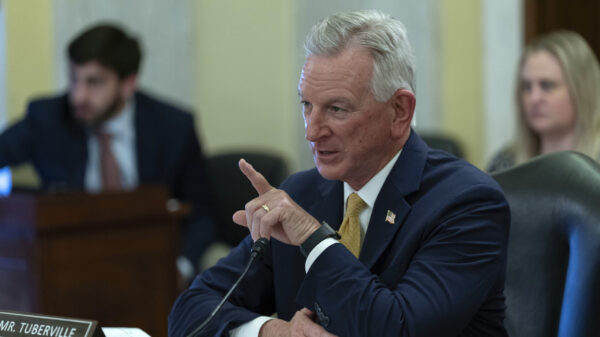By Brandon Moseley
Alabama Political Reporter
MONTGOMERY—Many conservatives and free market capitalist point to Walmart as an example of what is right with the free market system. Others see the world’s biggest retailer as a pariah that offers low prices on the back of low wages.
Many of those who praise Walmart’s capitalism also decry Medicaid as part of the welfare state.
But other than lower wages and low prices, the super retailer in many states is a big driver of Medicaid cost.
According to Alabama’s Medicaid agency, “In the first seven months of 2012, an average of 40 percent of all children who applied for Medicaid (either the Medicaid for Low Income Families or the SOBRA Medicaid programs) had at least one parent who was working (earning income). This does not include children who receive Medicaid due to disability (e.g. SSI).”
These people are what is commonly known as the working poor, many of them work at Walmart, for them the company slogan, save money, live better may not be all that true.
In 2005, Walmart held a conference billed as “An In-Depth Look at Wal-Mart and Society” this a part of the company’s campaign to address criticism of the wages, healthcare benefits, and workplace policies for its 1.2 million employees. Walmart Stores Inc., had asked nine economists to assess the retail giant’s affect on the economy.
The company was not pleased with all that was revealed and little has changed in Walmart’s corporate culture and business operations in the US and around the globe.
Not only did they learn that “residents of a local labor market do indeed earn less following the opening of Walmart stores,” said David Neumark, an economist with the Public Policy Institute of California, who spoke at the forum, but also that Walmart added to the Medicaid roles.
Another conference participant, Michael Hicks, an economist at the Air Force Institute of Technology at Wright-Patterson Air Force Base in Dayton, Ohio, studied Walmart’s effect on government anti-poverty programs and found that Walmart increased Medicaid costs an average of $898 per worker, according to Bloomberg News.
Bloomberg also said that Hicks found that a 1 percent increase in Walmart’s market share in a state is accompanied by a 1.5 percent increase in Medicaid spending. Walmart insures fewer than half its employees, many of whom cannot afford to pay for their own health insurance.
Hicks found that government aid to needy families decreased by 3.3 percent with every 1 percent increase in Walmart’s market share.
During the same period, the “Montgomery Advertiser” reported about Walmart, “Data from the Alabama Medicaid Agency showing that Walmart topped the list of companies with the most employees with children on Medicaid. The retailer accounted for some 3,864 enrollees who were costing the state between $5.8 million and $8.2 million a year.”
While Walmart has contributed to growth in the Medicaid cost in Alabama it has also received substantial subsidies from local governments. While Alabama has no central database to keep track of tax breaks and cash inducements to business, Good Jobs First supplies this list of some Walmart around the state.
These 10 deals are worth a total of about $49.8 million in Alabama. They include the following:
Wal-Mart subsidies in the following cities
Birmingham (Crestwood Blvd), AL : $11 million
Birmingham (Parkway E), AL : $10 million
Birmingham (Trussville), AL : $3 million
Brundidge, AL : $5 million
Cullman, AL : more than $12 million
Gardendale, AL : $4 million
Leeds, AL : more than $500,000
Mobile, AL : $992,000
Opelika, AL : $2.2 million
Pell City, AL : $1.1 million
These cash and tax incentives paid with citizens tax dollars, are repeated over again in many states. But some state legislators are starting to weight the high cost of low price.
Recent studies showed that in early 2011, Walmart led all Missouri employers with 10,028 employees and their dependents enrolled in Missouri’s Medicaid program. In FY09, Walmart led all employers in Massachusetts with 10,171 employees and their dependents using publicly subsidized healthcare. And in 2011 Walmart topped the list of Medicaid employers with Medicaid enrollees in Connecticut.
January, 2012, Good Jobs First found that “taxpayers are forced to provide healthcare for Walmart’s Associates.” Hundreds of thousands of Associates and their family members qualify for publicly-funded health insurance. According to data compiled by Good Jobs First, in 21 of 23 states which have disclosed information, Walmart has the largest number of employees on the public rolls of any employer.
In 2012 Walmart stopped offering health insurance to part-time employees (working less than 24 hours per week). But of the many who do qualify for the company plan only a few can actually afford what the company offers.
The 2012 Associate Benefits Book, distributed to Walmart employees, advertises Medicaid and CHIP premium assistance programs for employees who eligible for Walmart’s health insurance but are “unable to afford the premiums.” The handbook also lists contact information for assistance programs by state.
Of course, Walmart is not the only company whose employees receive Medicaid benefits but studies show they may be the biggest.

















































